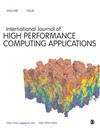Productively accelerating positron emission tomography image reconstruction on graphics processing units with Julia
IF 2.5
3区 计算机科学
Q2 COMPUTER SCIENCE, HARDWARE & ARCHITECTURE
International Journal of High Performance Computing Applications
Pub Date : 2022-03-22
DOI:10.1177/10943420211067520
引用次数: 0
Abstract
Research in medical imaging is hampered by a lack of programming languages that support productive, flexible programming as well as high performance. In search for higher quality imaging, researchers can ideally experiment with novel algorithms using rapid-prototyping languages such as Python. However, to speed up image reconstruction, computational resources such as those of graphics processing units (GPUs) need to be used efficiently. Doing so requires re-programming the algorithms in lower-level programming languages such as CUDA C/C++ or rephrasing them in terms of existing implementations of established algorithms in libraries. The former has a detrimental impact on research productivity and requires system-level programming expertise, and the latter puts severe constraints on the flexibility to research novel algorithms. Here, we investigate the use of the Julia scientific programming language in the domain of PET image reconstruction as a means to obtain both high performance (portability) on GPUs and high programmer productivity and flexibility, all at once, without requiring expert GPU programming knowledge. Using rapid-prototyping features of Julia, we developed basic and performance-optimized GPU implementations of baseline maximum likelihood expectation maximization (MLEM) positron emission tomography (PET) image reconstruction algorithms, as well as multiple existing algorithmic extensions. Thus, we mimic the effort that researchers would have to invest to evaluate the quality and performance potential of algorithms. We evaluate the obtained performance and compare it to state-of-the-art existing implementations. We also analyse and compare the required programming effort. With the Julia implementations, performance in line with existing GPU implementations written in the low-level, unproductive programming language CUDA C is achieved, while requiring much less programming effort, even less than what is needed for much less performant CPU implementations in C++. Switching to Julia as the programming language of choice can therefore boost the productivity of research into medical imaging and deliver excellent performance at a low cost in terms of programming effort.在图形处理单元上使用Julia有效地加速正电子发射断层成像图像重建
由于缺乏支持高效、灵活和高性能编程的编程语言,医学成像研究受到了阻碍。为了寻找更高质量的成像,研究人员可以理想地使用快速原型语言(如Python)进行新算法的实验。然而,为了加快图像重建的速度,需要有效地利用图形处理器(gpu)等计算资源。这样做需要在较低级别的编程语言(如CUDA C/ c++)中重新编程算法,或者根据库中已建立算法的现有实现来重新表述它们。前者对研究效率有不利影响,需要系统级编程专业知识,后者严重限制了研究新算法的灵活性。在这里,我们研究了Julia科学编程语言在PET图像重建领域的使用,作为在GPU上获得高性能(可移植性)和高程序员生产力和灵活性的一种手段,同时不需要专业的GPU编程知识。利用Julia的快速原型功能,我们开发了基线最大似然期望最大化(MLEM)正电子发射断层扫描(PET)图像重建算法的基本和性能优化的GPU实现,以及多个现有算法扩展。因此,我们模仿研究人员必须投入的努力来评估算法的质量和性能潜力。我们评估获得的性能,并将其与最先进的现有实现进行比较。我们还分析和比较了所需的编程工作。使用Julia实现,性能与现有的GPU实现一致,用低级,非生产性编程语言CUDA C编写,同时需要更少的编程工作,甚至比在c++中性能更低的CPU实现所需的更少。因此,切换到Julia作为选择的编程语言可以提高医学成像研究的生产力,并在编程工作方面以低成本提供出色的性能。
本文章由计算机程序翻译,如有差异,请以英文原文为准。
求助全文
约1分钟内获得全文
求助全文
来源期刊
CiteScore
6.10
自引率
6.50%
发文量
32
审稿时长
>12 weeks
期刊介绍:
With ever increasing pressure for health services in all countries to meet rising demands, improve their quality and efficiency, and to be more accountable; the need for rigorous research and policy analysis has never been greater. The Journal of Health Services Research & Policy presents the latest scientific research, insightful overviews and reflections on underlying issues, and innovative, thought provoking contributions from leading academics and policy-makers. It provides ideas and hope for solving dilemmas that confront all countries.

 求助内容:
求助内容: 应助结果提醒方式:
应助结果提醒方式:


